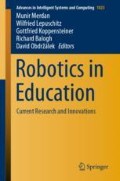Abstract
The involvement of arts and psychology elements in robotics research for children with cognitive impairment is still limited. However, the combination of robots, arts, psychology and education in the development of robots could significantly contribute to the improvement of social interaction skills among children with cognitive impairment. In this article, we would like to share our work on building and innovating the costume of LUCA’s robot, which incorporating the positive psychological perspectives and arts values for children with cognitive impairment. Our goals are (1) to educate arts students in secondary arts school on the importance of social robot appearance for children with cognitive impairment, and (2) to select the best costume for future child-robot interaction study with children with cognitive impairments.
Access this chapter
Tax calculation will be finalised at checkout
Purchases are for personal use only
References
Dautenhahn, K.: Roles and functions of robots in human society: implications from research in autism therapy. Robotica 21(4), 443–452 (2003)
Goetz, J., Kiesler, S., Powers, A.: Matching robot appearance and behavior to tasks to improve human-robot cooperation. In: Proceedings of the 12th IEEE International Workshop on Robot and Human Interactive Communication, pp 55–60. IEEE Press Piscataway (2003)
Grandgeorge, M., Masataka, N.: Atypical color preference in children with autism spectrum disorder. Front. Psychol. 7, 1976 (2016)
Kennedy, J., Baxter, P., Belpaeme, T.: The robot who tried too hard: social behaviour of a robot tutor can negatively affect child learning. In: Proceedings of the Tenth Annual ACM/IEEE International Conference on Human-robot Interaction, pp. 67–74. ACM (2015)
Lasota, P.A., Fong, T., Shah, J.A., et al.: A survey of methods for safe human-robot interaction. Found. Trends® Robot. 5(4), 261–349 (2017)
Pachidis, T., Vrochidou, E., Kaburlasos, V., Kostova, S., Bonković, M., Papić, V.: Social robotics in education: state-of-the-art and directions. In: International Conference on Robotics in Alpe-Adria Danube Region, pp. 689–700. Springer (2018)
Robins, B., Dautenhahn, K., Dubowski, J.: Does appearance matter in the interaction of children with autism with a humanoid robot? Inter. Stud. 7(3), 479–512 (2006)
Scassellati, B., Admoni, H., Matarić, M.: Robots for use in autism research. Ann. Rev. Biomed. Eng. 14, 275–294 (2012)
Tapus, A., et al.: Children with autism social engagement in interaction with Nao, an imitative robot: a series of single case experiments. Inter. Stud. 13(3), 315–347 (2012)
Vandevelde, C., Wyffels, F., Vanderborght, B., Saldien, J.: An open-source hardware platform to encourage innovation. IEEE Robot. Autom. Mag. 1070(9932/17), 2 (2017)
Young, J.E., Hawkins, R., Sharlin, E., Igarashi, T.: Toward acceptable domestic robots: applying insights from social psychology. Int. J. Social Robot. 1(1), 95 (2009)
Funding
Luthffi Idzhar Ismail received a Postgraduate Education Fund from Majlis Amanah Rakyat, MARA (MARA REF: 330407445608). This work was partially funded by the Niche Research Grant Scheme (NRGS):600-RMI/NRGS 5/3 (11/2013).
Author information
Authors and Affiliations
Corresponding author
Editor information
Editors and Affiliations
Ethics declarations
The authors declare that they have no conflict of interest.
Rights and permissions
Copyright information
© 2020 Springer Nature Switzerland AG
About this paper
Cite this paper
Ismail, L.I., Hanapiah, F.A., wyffels, F. (2020). User-Driven Design of Robot Costume for Child-Robot Interactions Among Children with Cognitive Impairment. In: Merdan, M., Lepuschitz, W., Koppensteiner, G., Balogh, R., Obdržálek, D. (eds) Robotics in Education. RiE 2019. Advances in Intelligent Systems and Computing, vol 1023. Springer, Cham. https://doi.org/10.1007/978-3-030-26945-6_36
Download citation
DOI: https://doi.org/10.1007/978-3-030-26945-6_36
Published:
Publisher Name: Springer, Cham
Print ISBN: 978-3-030-26944-9
Online ISBN: 978-3-030-26945-6
eBook Packages: Intelligent Technologies and RoboticsIntelligent Technologies and Robotics (R0)

